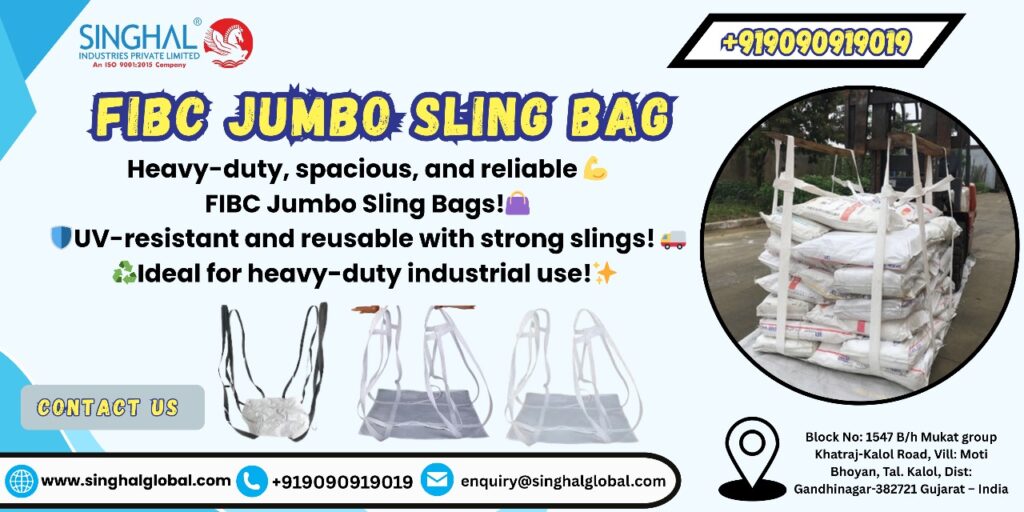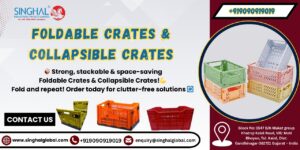Walk through any cement yard, fertilizer plant, or construction site today, and you’ll likely find them—those massive white fabric bags sitting confidently in a row, lifting and storing thousands of kilos of material with ease. These aren’t just bags. They’re powerhouses of modern packaging—and they go by the name FIBC Sling Bags.
They’re the behind-the-scenes heroes nobody knows. Unassuming. Durable. Flexible. And yes—completely underappreciated.
With faster supply chains and slimmer margins in today’s world, packaging is no longer a backroom job. It’s the foundation for efficiency, safety, and sustainability. And at the heart of this revolution lies the FIBC Sling Bag—a smart offshoot of the famous FIBC bulk bags. but why are they the future of industrial packaging? Let’s dig in.
First, What Is an FIBC Sling Bag?
FIBC, or Flexible Intermediate Bulk Container, is already a revolution in packaging. It is a compliant bag made out of a woven polypropylene that is utilized as a container and shipped wet bulk commodities which include cement, grains, minerals, and powders among others.
But FIBC Sling Bags? They push the concept one step further. Rather than four lifting loops on the corners of standard FIBC jumbo bags, sling bags generally feature two heavy-duty lifting belts or slings that traverse under the bag and upwards on each side. They consist of these belts, which are crane-friendly arms, which can be used in worksites or high-speed loading zones.
This type of sling design implies:
- Quicker lifting with cranes or hooks
- Fewer workers are needed for manual handling.
- More safety when in transit
It’s no surprise that FIBC bags manufacturers from around India and the world are increasing production of sling types.
Real-Life Insight: The Brick Factory That Switched
Let’s discuss Sharma Brothers, a brick factory situated in Haryana. They used to pack their bricks into metal cages for shipping for many years. The process was time-consuming, risky, and costly. Workers used to get hurt when they handled those heavy cages:
- 50% reduction in loading time
- Less breakage in transit
- No rusty metal containers anymore
And the cherry on top? They could use the same bags up to 8-10 times.
Their supervisor commented, “At first, we didn’t believe in a cloth bag being able to carry our bricks. Now, we don’t believe in anything else.”
How Is a Sling Bag Different from a Regular FIBC Bag?
Excellent question—and one many first-time buyers wonder.
The fundamental difference is in the lifting mechanism. While a typical FIBC bag is fitted with four corner loops designed for forklifts, there are two long belts in a sling bag that go right across the bottom and loop up for crane lifting. These belts provide improved weight distribution and are suited for top-lifting construction site jobs.
Sling bags too are single and/or a double-loop bag connotations:
- Simpler loading and unloading with hooks
- Faster rotation in busy environments
Functionally, they’re similar. But structurally, sling bags are better suited for large, rough materials like:
- Bricks and blocks
- Cement
- Sand
- Stones or aggregates
Why Sling Bags Are the Smart Choice
Here’s what makes them shine:
Efficient Loading/Unloading
No need to bring a forklift everywhere. Just attach a crane hook and go.
Stronger Base Support
Sling belts support the entire bottom, reducing stress on seams.
Safer Handling
Less shifting during transport. More stability when suspended.
Compact Storage
Fold flat when empty—saving tons of space.
Are FIBC Sling Bags Reusable or Single-Use?
It depends.
A typical well-designed FIBC sling bag will possess a safety factor not less than 5:1 to 6:1, i.e. it is tested at 5 6 or rated capacity. This qualifies them for multiple usage—particularly in carrying non-hazardous, dry commodities.
But you must check bags before every reuse:
- Check for frayed stitching
- Inspect sling belts for wear.
- Watch out for tears or thinning of fabric.
And naturally, if the bag was used for hazardous or poisonous materials, it’s better to discard it after a single use.
Some FIBC bags manufacturers even have refurbishment services, where used bags are washed, restored to their original condition, and prepared for reuse—thus making them an even eco-friendly option.
Types of Sling Loops Available
There’s diversity here as well. Depending on whether you wish to fill or lift the bag in a specific manner, you have the option to select:
- Single Sling Loop: Fast crane lifting using a single hook
- Double Sling Loop: Stabilised lifting, improved weight transfer
- Cross Corner Loops- Hybrid which can be used along with forklifts
- Stevedore Loops: They are great to use in shipping and handling of containers
Every type of loop has its advantages. Double loops, for instance, work well for longer loads such as logs or steel rods, whereas single-loop sling bags are suitable when speed and convenience are paramount.
If you’re not sure, get your FIBC bags producer to demonstrate sample bags or try out lifting prior to a large-scale purchase.
What About Cost?
You may believe sling bags are more costly. But here’s the surprise—they end up saving money in the long run.
- Less labour expense for loading
- Fewer breakage losses
- Reusable for 8–10 trips
- Less packaging waste
- Easier handling = fewer injuries
And with FIBC bag manufacturers in India providing competitive prices and bulk discounts, the initial investment pays itself off in a matter of months.
Conclusion
In a globe haste toward efficiency, FIBC sling bags take centre stage as an emblem of intelligent, scalable, and sustainable packaging.
They aren’t just bags. They’re solutions to labour issues, cost pressures, storage headaches, and transport delays. Whether you’re moving sand in Surat or bricks in Bangalore, sling bags can simplify your process, safeguard your product, and even support your workforce.
So if you still employ old packaging systems, perhaps it’s time to make the change. Contact a reliable FIBC jumbo bag vendor or local FIBC bags Manufacturers, take a batch for a test run, and experience the difference firsthand.
Frequently Asked Questions (FAQs)
Q1. How is a sling bag different from a regular FIBC bag?
It has sling lifting belts rather than four corner loops—perfect for crane-based lifting.
Q2. Are FIBC Sling Bags reusable or single-use?
Reusable if well-maintained. Do not reuse the following hazardous material storage.
Q3. What types of sling loops are available?
Single, double, cross-corner, and stevedore loops—each suits different lifting purposes.
Q4. How do I store FIBC Sling Bags when not in use?
Roll the remaining and store at a cool and sunny location. Avoid moisture and UV exposure.









